

Dyrnwyn, the Sword of Rhydderch Hael. Gan Jiang and Mo Ye. Gan Jiang (Chinese: 干將; pinyin: Gān Jiàng) and Mo Ye (Chinese: 莫邪; pinyin: Mò Yé) were a swordsmith couple who lived during the Spring and Autumn Period of Chinese history.
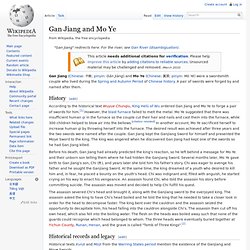
A pair of swords were forged by and named after them. History[edit] According to the historical text Wuyue Chunqiu, King Helü of Wu ordered Gan Jiang and Mo Ye to forge a pair of swords for him.[1] However, the blast furnace failed to melt the metal. Mo Ye suggested that there was insufficient human qi in the furnace so the couple cut their hair and nails and cast them into the furnace, while 300 children helped to blow air into the bellows. [citation needed] In another account, Mo Ye sacrificed herself to increase human qi by throwing herself into the furnace. Before his death, Gan Jiang had already predicted the king's reaction, so he left behind a message for Mo Ye and their unborn son telling them where he had hidden the Ganjiang Sword.
Hrunting. Sword Kladenets. Kladenets (Russian: меч-кладенец; also called самосёк [samosyok]) is a fabulous magic sword in some Old Russian fairy tales.
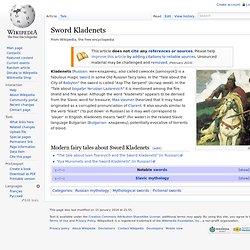
In the "Tale about the City of Babylon" the sword is called "Asp The Serpent" (Аспид-змей). In the "Tale about bogatyr Yeruslan Lazarevich" it is mentioned among the fire shield and fire spear. Although the word "kladenets" appears to be derived from the Slavic word for treasure, Max Vasmer theorized that it may have originated as a corrupted pronunciation of Clarent. It also sounds similar to the verb "klast'" ('to put down' in Russian) so it may well correspond to 'slayer' in English. Nægling. This article is about the sword in Beowulf, not to be confused with the blade used by Oromis in Eldest and Brisingr of the Inheritance Cycle.
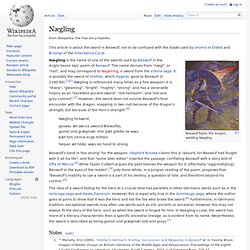
Beowulf fights the dragon, wielding Nægling. Nægling forbærst,geswác æt sæcce sweord Bíowulfes, gomol ond grǽgmǽl. Him þæt gifeðe ne wæs þæt him írenna ecge mihton helpan æt hilde; wæs sío hond tó strong. Ruyi Jingu Bang. A 19th-century drawing of Sun Wukong featuring his staff.
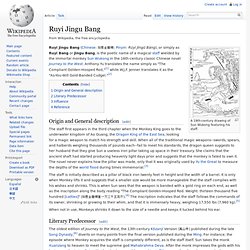
Origin and General description[edit] The staff is initially described as a pillar of black iron twenty feet in height and the width of a barrel. It is only when Monkey lifts it and suggests that a smaller size would be more manageable that the staff complies with his wishes and shrinks. This is when Sun sees that the weapon is banded with a gold ring on each end, as well as the inscription along the body reading "The Compliant Golden-Hooped Rod. Weight: thirteen thousand five hundred [catties]" (如意金箍棒重一万三千五百斤).[4] The inscription indicates that the staff follows the commands of its owner, shrinking or growing to their whim, and that it is immensely heavy, weighing 17,550 lbs (7,960 kg).[5] Sharur (mythological weapon) Sharur, which means "smasher of thousands" is the weapon and mythic symbol of the god Ninurta.

Sumerian mythic sources describe it as an enchanted talking mace. It has been suggested as a possible precursor for similar objects in other mythology such as Arthurian lore. Sharur plays a prominent role in an incident in which Ninurta is described as using it to defeat Asag, a monstrous demon; Sharur has the power to fly across vast distances without impediment and communicate with its wielder. Shamshir-e Zomorrodnegar. Shamshir-e Zomorrodnegār (Persian: شمشیر زمردنگار, 'the emerald-studded sword') is a sword in the Persian legend Amir Arsalan.
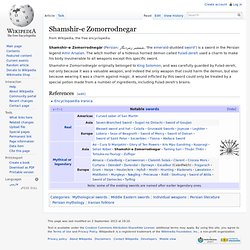
The witch mother of a hideous horned demon called Fulad-zereh used a charm to make his body invulnerable to all weapons except this specific sword. Shamshir-e Zomorrodnegār originally belonged to King Solomon, and was carefully guarded by Fulad-zereh, not only because it was a valuable weapon, and indeed the only weapon that could harm the demon, but also because wearing it was a charm against magic. A wound inflicted by this sword could only be treated by a special potion made from a number of ingredients, including Fulad-zereh's brains. Encyclopaedia Iranica.
Skofnung. Skofnung was the sword of legendary Danish king Hrólf Kraki.
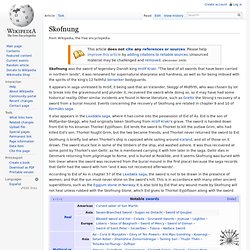
"The best of all swords that have been carried in northern lands", it was renowned for supernatural sharpness and hardness, as well as for being imbued with the spirits of the king's 12 faithful berserker bodyguards. It appears in saga unrelated to Hrólf, it being said that an Icelander, Skeggi of Midfirth, who was chosen by lot to break into the gravemound and plunder it, recovered the sword while doing so, so it may have had some historical reality. Thunderbolt. Zeus' head and thunderbolt on a coin from Epirus, 234 BC.

Zeus' head and thunderbolt on a coin from Capua, Campania, 216-211 BC. Coin of Ptolomaic Egypt showing Zeus as an Eagle, holding a thunderbolt In mythology[edit] Neo-Attic bas-relief sculpture of Jupiter, holding a thunderbolt in his right hand; detail from the Moncloa Puteal (Roman, 2nd century), National Archaeological Museum, Madrid. Vajra.